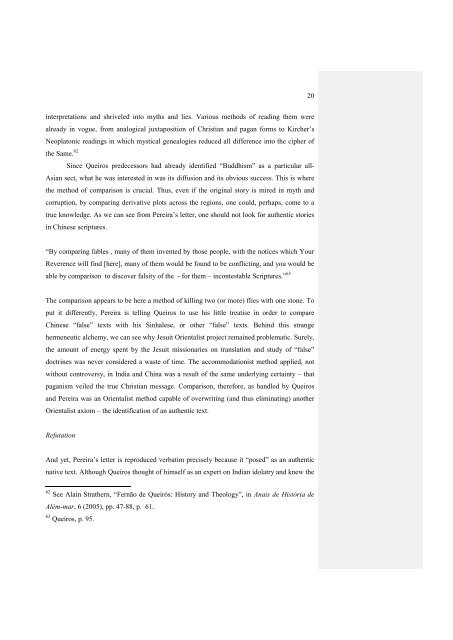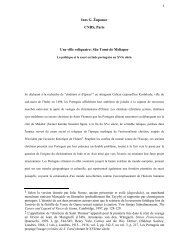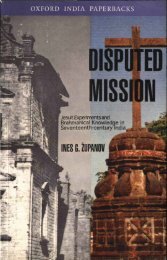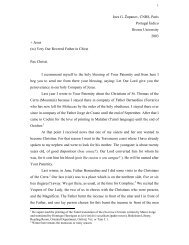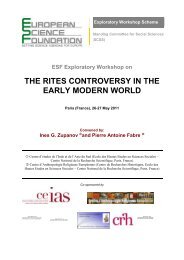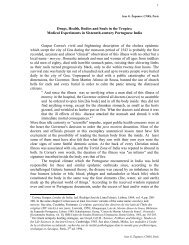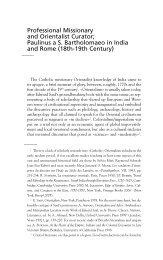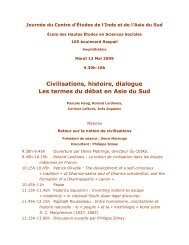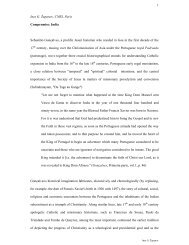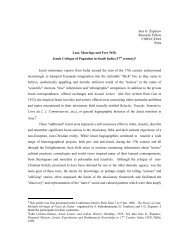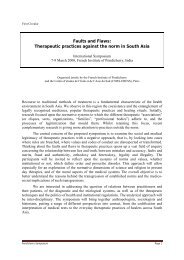Jesuit Orientalism; - Ines G. Županov
Jesuit Orientalism; - Ines G. Županov
Jesuit Orientalism; - Ines G. Županov
You also want an ePaper? Increase the reach of your titles
YUMPU automatically turns print PDFs into web optimized ePapers that Google loves.
20<br />
interpretations and shriveled into myths and lies. Various methods of reading them were<br />
already in vogue, from analogical juxtaposition of Christian and pagan forms to Kircher‟s<br />
Neoplatonic readings in which mystical genealogies reduced all difference into the cipher of<br />
the Same. 62<br />
Since Queiros predecessors had already identified “Buddhism” as a particular all-<br />
Asian sect, what he was interested in was its diffusion and its obvious success. This is where<br />
the method of comparison is crucial. Thus, even if the original story is mired in myth and<br />
corruption, by comparing derivative plots across the regions, one could, perhaps, come to a<br />
true knowledge. As we can see from Pereira‟s letter, one should not look for authentic stories<br />
in Chinese scriptures.<br />
“By comparing fables , many of them invented by those people, with the notices which Your<br />
Reverence will find [here], many of them would be found to be conflicting, and you would be<br />
able by comparison to discover falsity of the - for them – incontestable Scriptures.” 63<br />
The comparison appears to be here a method of killing two (or more) flies with one stone. To<br />
put it differently, Pereira is telling Queiros to use his little treatise in order to compare<br />
Chinese “false” texts with his Sinhalese, or other “false” texts. Behind this strange<br />
hermeneutic alchemy, we can see why <strong>Jesuit</strong> Orientalist project remained problematic. Surely,<br />
the amount of energy spent by the <strong>Jesuit</strong> missionaries on translation and study of “false”<br />
doctrines was never considered a waste of time. The accommodationist method applied, not<br />
without controversy, in India and China was a result of the same underlying certainty – that<br />
paganism veiled the true Christian message. Comparison, therefore, as handled by Queiros<br />
and Pereira was an Orientalist method capable of overwriting (and thus eliminating) another<br />
Orientalist axiom – the identification of an authentic text.<br />
Refutation<br />
And yet, Pereira‟s letter is reproduced verbatim precisely because it “posed” as an authentic<br />
native text. Although Queiros thought of himself as an expert on Indian idolatry and knew the<br />
62 See Alain Strathern, “Fernão de Queirós: History and Theology”, in Anais de História de<br />
Além-mar, 6 (2005), pp. 47-88, p. 61.<br />
63 Queiros, p. 95.


